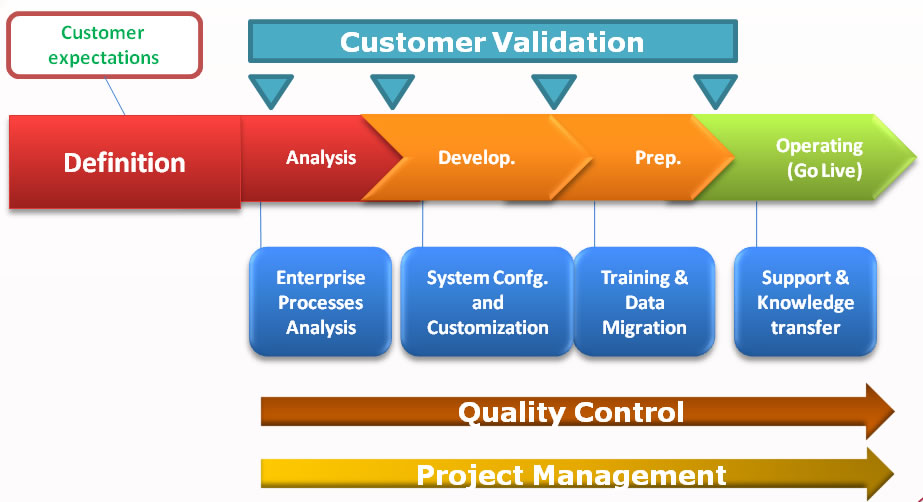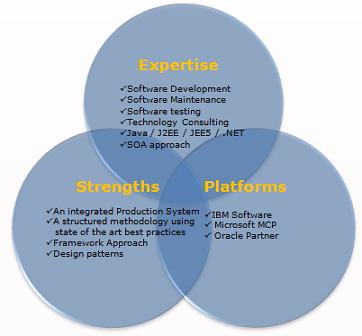
TAFEEL and Argon partnership
TAFEEL has signed a contract for a strategic long-term partnership with ARGON the world's pioneer consulting firm.
TAFEEL's website launch
TAFEEL is proud to announce the lanuch of its website.




Our methodology is a framework of related elements that involves phases, processes, tasks and dependencies.
- A task is a unit of work, which results in a single deliverable. That deliverable may take many different forms like reports, schedules, code, or test results for example.
- A process is a closely related group of dependent tasks, which meets a major objective. A process is usually based on a common discipline.
- A phase is a chronological grouping of tasks. It enables a flexible way to organize tasks, schedule major deliverables, and deliver projects.
Phases
Definition:
The goal of the Definition phase is to plan the project, and rapidly establish a preconfigured and tested environment for familiarizing the implementing organization with the Business Flows being implemented. During Definition, workshops are conducted to educate the organization about critical decisions to be made regarding application architecture components, such as the Chart of Accounts Structure, Multi-Org Structure, and Trading Community Architecture. These workshops are also intended to assist the customer in defining those entities.
Definition Phase Objectives
The objectives of the Definition phase follow:
- Verify senior executives’ buy-in to the project.
- Facilitate informed project start-up decisions.
- Build consensus around project direction, scope, objectives and approach.
- Familiarize customer with Business Flows
- Perform initial mapping of Business Flows to the client’s business
- Develop the Business Requirements Mapping Document (BR.030).
- Determine the high-level architectural, technological, and configuration
- Requirements to support the functional and information needs of the application system.
- Define the project scope clearly.
- Obtain management approval to proceed with Elaboration.
Analysis
During the Analysis phase, we try to understand of current business practices and identify areas for improvements. The objective is to develop a comprehensive list of requirements. Also during this phase, the core project team members gain a thorough understanding of the software application, prepares the Business Requirement Specification which is transformed to Functional Requirement Specifications. These specifications map the functionality of the software to the requirements of the project/application/organization. Any gaps between the functionality of the software to the requirements of the organization is highlighted and documented. Included in this phase are the following activities:
- Defined Business Requirements
- Preliminary Project Plan
- Information Architecture Review
- Functional Requirement Specification
- Trained Project Team
- Preliminary Architecture Plan
- User Experience: Wire frames
- Detailed Architecture Specification
- Detailed Technical Design Documentation
- Complete set of screenshots and/or clickable HTML prototype
- Test Plan Outline

Development:
This phase includes the actual development/coding of programs. Included in this phase are the following activities:
- Interface Development
- Custom Enhancement Development
- Package structure
- Modules
- Naming conventions
- Best Practices
- Interface Programs & Documentation
- System Test Report/Validation
- Test Plan
- Documentation
preparation:
With heightened media awareness, shareholder concerns and regulatory involvement, data migrations are subjected to intense scrutiny. It has become critical to simultaneously manage various transaction risks to realize projected savings and gain operational efficiencies in a merger. Understanding the accuracy of various sources of data (such as customers, inventory and vendors) is critical to successfully managing exposure
It is not sufficient to provide a quick training class and submerge employees in a new system environment. This results in severe anxiety for your users, poor adoption of the new system and can result in a failed implementation. For this reason, our training approach focuses on developing user comfort with the applications they will be using. When you go live, we want your users to know their part of the system and feel comfortable with it. We divide training into two types.
Project Team Training:
The assigned project lead(s) and project team members will be provided top-level training on the entire system to provide an overview of the modules and how they are set up. This training will occur early in the implementation so your people and TAFEEL can approach the implementation as a team. This is the best way to leverage your expert knowledge of your business, our expert knowledge of the software and our general implementation knowledge. This training is usually done off-site in a training center that can let the team members focus on the training without the interruptions of day to day business.End-User Classroom Training:
This is the formal part of the training that occurs after the conference room pilot. We recommend setting up a small training room at your facility where training can be provided on computers. It is important that users perform exercises as part of the training. This increases information retention.
Go-Live!
During the go-live period TAFEEL consultants will be onsite to ensure that all requirements have been covered to ensure a smooth transition onto the new business system. It is at this time that all tasks on the project plan have been complete, all users trained, all processes re-engineered, and the final data migration/conversion is performed

